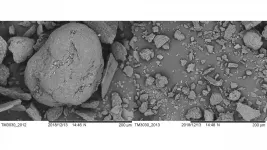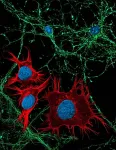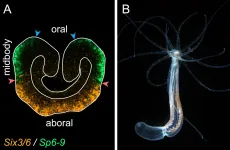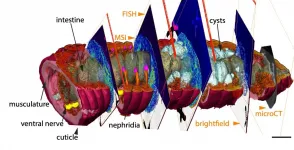(Press-News.org) WASHINGTON, June 29, 2021 - For more than 60 years, algae have been studied as a potential feedstock for biofuel production, but the cellulose in their cell wall makes it hard to access the critical molecules inside and convert them to biogas.
In the Journal of Renewable and Sustainable Energy, from AIP Publishing, an international research team reports their success in using urea and sodium hydroxide (NaOH, commonly known as lye or caustic soda) as a pretreatment of algae, which breaks down cellulose and more than doubles biogas production under their initial experimental conditions.
"We were inspired by previously published results showing the promise of NaOH and urea in altering the solubility of cellulose," said co-author Yue Shi. "We wanted to explore whether this could help us overcome one of the big challenges of digesting algae."
To produce biogas from algae, researchers commonly use a naturally occurring process called anerobic digestion, in which a type of bacteria break down the algae and produce a methane-rich gas mixture that can be purified. The resulting methane can be used in the production of heat, electricity, methanol, car fuel, and other clean energy sources.
This study presents the first steps toward optimizing conditions for such energy production, testing variations in time, temperature, and concentration of lye-urea pretreatment. Specifically, the most effective combination in this study was a 50-minute pretreatment at -16?C with a lye-urea concentration of 5.89%.
"The interactions between variables were also evident in our results," said Shi. "The microstructural changes that resulted from pretreatment were obvious upon imaging using scanning electron microscopy."
Amidst growing concerns about the limited availability of fossil fuels and their potentially detrimental effects on our environment, global interest in affordable and renewable energy is growing. Moreover, identifying environmentally detrimental materials as the raw materials for these processes could be dual purpose.
The circular economy model, for example, proposes recovery of waste resources and environmentally detrimental products at their source can be used as feedstocks for materials capable of replacing existing resources.
In the study, the feedstock was Enteromorpha, a macroalgae or seaweed responsible for green tide, an algal overgrowth that is damaging to tourism, aquaculture, and natural ecosystems. The global economic and ecological impacts of green tide have been increasing in scale and frequency since the 1960s.
Capturing this seasonal and emergent algae and converting it into a cost-effective and sustainable biofuel would have social and economic benefits beyond clean energy and bring us closer to a circular economy.
INFORMATION:
The article, "NaOH-Urea pretreatment for biogas enhancement from algal biomass anaerobic digestion," is authored by Yue Shi, RuiZhe Feng, Asad A. Zaidi, QiaoYan Li, and Kun Zhang. The article will appear in Journal of Renewable and Sustainable Energy on June 29, 2021 (DOI: 10.1063/5.0048341). After that date, it can be accessed at https://aip.scitation.org/doi/10.1063/5.0048341.
With advances in medical science driving progress against childhood brain tumors, today three out of four young patients survive at least five years beyond diagnosis. However, the outcomes look grim when malignant cells spread, or metastasize.
Such is the case with medulloblastoma, a type of brain cancer that arises in the cerebellum, at the back of the head. Although rare in absolute terms -- about 350 cases emerge each year, 60 percent of them in children -- medulloblastoma is the most common and deadliest form of pediatric brain cancer. Metastasis ...
In a new article in Nature Communications, a research group led by Grigory Genikhovich at the University of Vienna has found that the way the main body axis of sea anemones is patterned by different intensities of β-catenin signaling is similar to that of sea urchins and vertebrates. This suggests that this axial patterning mechanism already existed about 650 million years ago.
The positioning of all anatomical structures in an embryo is determined by systems of molecular coordinates, which are called body axes. Different regulatory genes are activated at specific locations along the body axes to drive the development of all body parts in correct places.
This process is very ...
Ludwig-Maximilians-Universitaet (LMU) in Munich researchers have shown how RNA-binding proteins modulate synaptic responses that mediate the transmission of nerve cell impulses.
Cells in the central nervous system possess a high degree of flexibility, which enables them to adapt to fluctuating demands and respond to changing patterns of neuronal activity. This is achieved by modulating the connections between nerve cells, which are mediated by structures called synapses that determine how neighboring neurons respond to stimulation. These adjustments in turn require the intracellular transport of mRNAs. Consequently, the required proteins ...
Earthworms experience constant chemical interactions with bacteria, fungi, plants and small invertebrates across soil ecosystems. Even within their tissues, earthworms harbor symbiotic microbes and small animal parasites that trigger internal metabolic responses such as innate immunity. To reveal the fundamental processes that enable animal-microbe symbioses to form and persist, we have to study their metabolic interactions in situ. By combining novel imaging techniques, a team of researchers around Benedikt Geier from the Max Planck Institute for Marine Microbiology ...
Skoltech researchers and their colleagues from Russia and the UK investigated the safety and efficacy of new chemistry in antisense oligonucleotides used to treat spinal muscular atrophy (SMA), a debilitating genetic disease. Their results may lead to the development of drugs with less toxicity and fewer injections needed thanks to prolonged action. The paper was published in the journal Nucleic Acid Therapeutics.
Antisense oligonucleotides are single stranded chemically modified fragments of DNA that target pre-messenger RNA, short bits of genetic information a ribosome reads to make a protein. Depending on how a particular antisense oligonucleotide works, the target mRNA can either be destroyed or undergo subtle changes in how it's spliced, i.e. how exons, the ...
Russian scientists have experimentally proved the existence of a new type of quasiparticle - previously unknown excitations of coupled pairs of photons in qubit chains. This discovery could be a step towards disorder-robust quantum metamaterials. The study was published in Physical Review B.
Superconducting qubits are a leading qubit modality today that is currently being pursued by industry and academia for quantum computing applications. However, the performance of quantum computers is largely affected by decoherence that contributes to a qubits extremely short lifespan and causes computational errors. Another ...
Pioneering research has revealed the erosion of ancient sediments found deep beneath Antarctic ice could be a vital and previously unknown source of nutrients and energy for abundant microbial life.
The study, led by the University of Bristol and published today in Nature's Communications Earth & Environment journal, sheds new light on the many compounds supporting various microbes which form part of a huge subglacial ecosystem.
Lead author Dr Beatriz Gill Olivas, a Post-Doctoral Research Associate at the University of Bristol, said: "Although the study focused on samples obtained from a single ...
During summer 2020, the Yangtze River basin experienced persistent, record-breaking meiyu rainfall. Likewise, the region suffered from severe flooding and water damage as accumulated rainfall broke records dating back to 1954. Regions outside the meiyu rain belt received significant summer rainfall as well, including Beijing, located in northeastern China.
Typically, an above average meiyu rainfall season follows a strong El Niño during the previous winter. However, summer 2020 followed a neutral El Niño-Southern Oscillation (ENSO) event. Therefore, scientists are working ...
A stimulating environment keeps the "hippocampus" - which is the brain's memory control center - young, so to speak. Causes of this are molecular mechanisms that affect gene regulation. These current findings from studies in mice provide clues as to why an active, varied life can help preserve mental fitness in old age. Researchers from the DZNE and the Center for Regenerative Therapies Dresden (CRTD) at the Technische Universität Dresden report on this in the journal Nature Communications.
Human DNA - and this also applies to mice - contains thousands of genes. However, it is not only the genetic blueprint that is decisive for the function of a cell and whether it is healthy or not, but above all which genes can be switched on or off. ...
FECYT - Spanish Foundation for Science and Technology - presented today at the headquarters of the National Museum of Science and Technology, MUNCYT, IN Alcobendas, the results of the third Social Perception Survey of scientific aspects of the COVID-19 in a debate moderated by Pampa García Molina, Editor-in-Chief of the SINC Agency, in which Raquel Yotti, Director of the Carlos III Health Institute of Madrid, Josep Lobera, Professor of Sociology at the Universidad Autónoma de Madrid (UAM) and scientific director of the Social Perception Survey on the scientific aspects of COVID-19 and ...







